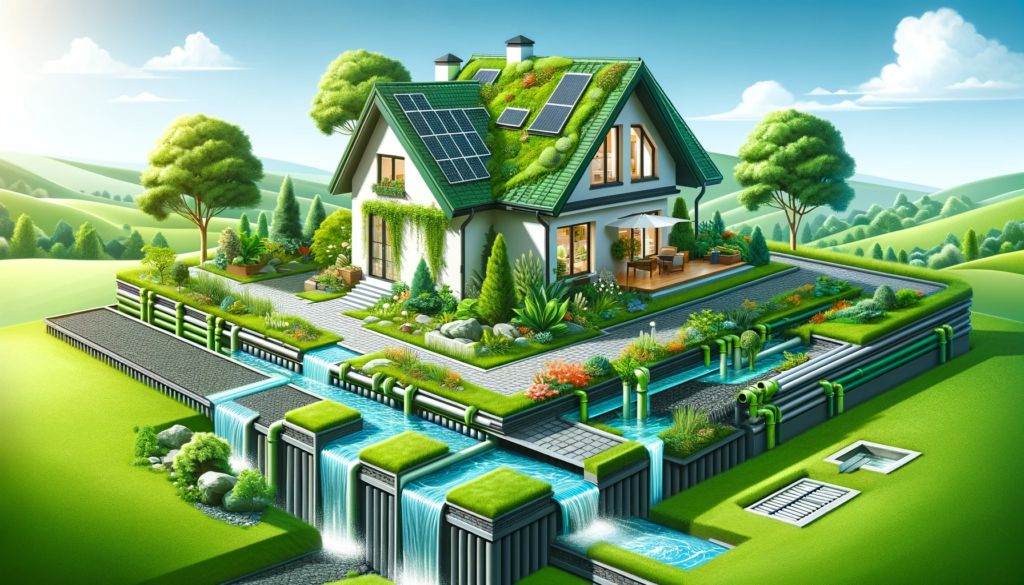Revolutionizing Home Drainage: Eco-Friendly Solutions for a Greener Future

Drainage is more than just a practical necessity; it’s an essential part of our homes that can significantly impact the environment. As homeowners, we’re increasingly conscious of the ecological footprint we leave. That’s why the shift towards eco-friendly drain solutions is not just beneficial; it’s crucial for a sustainable future. We have a role to play in conserving water, reducing pollution, and minimizing waste, and it all starts right beneath our sinks.
Embracing eco-friendly drain solutions carries a multitude of benefits. Not only do these green practices contribute to the health of our planet, but they can also lead to improved efficiency, cost savings, and an uplift in property value over time. By choosing sustainable options, we’re ensuring a cleaner world and a brighter future for generations to come.
Understanding Residential Drains
For many of us, the intricacies of home drainage systems remain out of sight and out of mind. But understanding these systems is the first step towards adopting more environmentally friendly practices. Traditional residential drains, while functional, often rely on methods and materials that are not the best for the environment. So how do we merge the need for effective drainage with eco-responsibility?
By incorporating greener alternatives such as rainwater collection tanks or permeable paving into our homes, we can effectively manage water drainage while reducing our environmental impact. This not only lessens water usage but also mitigates the harsh effects of urban runoff. It’s a win-win situation where our homes stay dry, and the Earth stays a little greener.
Types of Home Drainage Systems
When it comes to drainage systems, there’s an array of options to suit every home’s need and every homeowner’s green aspirations. Below is a comprehensive look at the types of systems you can integrate into your eco-friendly home plan:
Bioretention Systems:
These harness the natural filtration process of flora and soil, removing contaminants and stormwater from your property.
| Benefits | Description |
|---|---|
| Water Quality Improvement | Pollutants are naturally filtered out. |
| Wildlife Habitat | Supports local biodiversity. |
| Aesthetic Value | Adds visual appeal to landscaping. |
Rain Gardens:
Act as basins that collect rainwater, mainly from rooftops, allowing it to soak into the ground rather than enter the storm sewer system.
| Benefits | Description |
|---|---|
| Reduces Water Bills | Less reliance on treated water for gardens. |
| Flood Prevention | Minimizes water pooling around the home. |
Pervious Pavements:
These allow water to pass through the surface, facilitating natural soil absorption and reducing runoff.
| Benefits | Description |
|---|---|
| Longevity | Typically has a longer life than traditional pavement. |
| Low Maintenance | Less debris and reduced freeze-thaw cycles. |
Beyond these solutions, adopting simple practices such as installing low-flow showerheads or choosing eco-friendly cleaning products can synergize with these sustainable systems to optimize your home’s drainage.
The shift towards green plumbing is not just a trend; it’s a collective step towards a more sustainable living environment. Understanding and choosing the right type of eco-friendly drainage system for your home can be daunting, but the impact it has on our planet is well worth the effort.
Embracing eco-friendly drainage is about making informed decisions that align with environmental values. It’s about recognizing that every choice we make—down to the very pipes in our ground—can contribute to a more sustainable future.
DIY Drain Installation and Eco-Friendliness
Approaching DIY drain installation with eco-friendliness in mind is a commendable endeavor that ensures both immediate and long-term benefits. Here’s a list of tips to help you create a more environmentally responsible drainage system:
- Use Recycled Materials: Choose pipes and fittings made from recycled PVC or sustainable materials to minimize environmental impact.
- Proper Disposal: When replacing parts, dispose of old materials at a recycling center.
- Rain Harvesting: Install catchment systems to reuse rainwater for irrigation.
- Natural Slopes: Work with your home’s natural landscape to reduce the need for mechanical drainage systems.
Bringing a green mindset to your DIY projects not only contributes to a healthier planet but is often a learning experience that enriches your knowledge of sustainable living practices.
Essential Drain Maintenance Tips
Maintaining your eco-friendly drain doesn’t have to be complex or time-consuming. Here are essential, easy-to-apply tips to ensure the longevity and efficiency of your drainage system, the eco-conscious way:
- Regularly Clean Drain Covers
- Remove any debris to prevent blockages using natural brushes or homemade cleaning solutions.
- Natural Drain Cleaners:
- Use a mixture of baking soda and vinegar to clear minor clogs instead of harsh chemicals.
- Inspect for Leaks:
- Early detection and repair of leaks can prevent wasteful water use and protect surrounding soil from erosion.
- Invest in a Water Butt:
- Collect rainwater from downspouts and use it for garden irrigation.
Implementing these practices will not only keep your drainage system in top condition but will also serve as your contribution to a healthier environment.
Landscaping and Drainage: A Sustainable Pair
Green landscaping is more than just about aesthetics; it plays a crucial role in eco-friendly drainage solutions. Here’s how you can pair landscaping with sustainable drainage practices:
- Use Native Plants:
- They require less water and are more resilient to local pests, reducing the need for chemical treatments.
- Swales and Contours:
- Shape the land to naturally direct water flow, preventing erosion and promoting groundwater recharge.
Integrating your home’s drainage with landscaping efforts ensures a harmonious natural system, benefiting both your gardens and the environment.
Prevention: The Green Blockage Buster
Incorporating eco-friendly habits into your routine can significantly reduce the risk of drain blockages. To stay green while keeping drains clear:
- Avoid dumping oils and grease down the sink.
- Install sink strainers to catch food scraps and other solids.
- Educate everyone home about what can and can’t go down the drains.
- Regularly flush drains with hot (not boiling) water to maintain flow.
Combining these preventative measures with eco-friendly installation and maintenance yields a robust, sustainable drainage system.
As we consider the various aspects of drainage solutions, it’s evident that we have a plethora of green options at our disposal. From conscientious installation to everyday upkeep, these eco-friendly practices contribute to a sustainable household and a thriving planet.
Emergency Drainage Solutions: Keeping It Green
When a plumbing emergency strikes, it’s easy to resort to quick fixes that might not align with your environmental principles. Here’s a list of eco-friendly solutions to handle urgent drainage issues:
- Manual Drain Snakes: A hand-cranked drain snake can often clear blockages without the use of chemicals.
- Boiling Water: Sometimes, a pot of hot water can resolve a grease clog in your kitchen sink.
- Check for External Blockages: Inspect your property for roots or debris that may have compromised your drainage system.
Having these tools and methods at the ready ensures that even in emergencies, your solutions are eco-conscious and effective.
Seasonal Drainage Care with an Eco-Friendly Touch
With each season, your home’s drainage needs change. Adapting your care accordingly not only ensures optimal performance but also promotes environmental stewardship. Here are some seasonal tips for eco-friendly drainage care:
Spring:
Ensure gutters and downspouts are clear of debris after winter to minimize overflows and maximize rainwater collection.
Summer:
Consider using drought-resistant plants in your landscaping to keep water usage to a minimum.
Fall:
Regularly clean gutters and downspouts to prevent blockages from fallen leaves.
Winter:
Prepare pipes for colder temperatures by insulating them, which reduces the risk of burst pipes and water waste.
Adjusting your maintenance routine to the natural cycle of the seasons allows for a sustainable drainage approach all year long.
Smart Home Drainage: Marrying Technology and Sustainability
In our tech-driven world, intelligent systems have found a place in making our homes more efficient and environmentally friendly, including in drainage. Below are some examples of how tech can aid in eco-friendly drainage:
- Smart Water Monitors: These devices can track water usage and detect leaks early, preventing excess water waste and potential damage.
- Automated Rainwater Harvesting: Sophisticated systems can ensure optimal use of collected rainwater for non-potable purposes like irrigation.
- Eco-Smart Appliances: Products like smart dishwashers and washing machines can manage water usage effectively, putting less strain on your home’s drainage.
Integrating smart technology into your home’s drainage system can lead to a significant reduction in your ecological footprint.
Retrofitting Drain Systems for Environmental Benefit
Older homes might not have been built with eco-consciousness in mind, but that doesn’t mean they can’t be updated. Retrofitting your drainage system can profoundly affect environmental sustainability. Here are some considerations when planning an eco-friendly retrofit:
- Assess Current System: Understand what you have and identify areas for improvement.
- Use Sustainable Materials: Choose eco-friendly pipes and fixtures wherever possible.
- Consult Professionals: Work with experts who specialize in green plumbing solutions.
Retrofitting is not just about updating your home; it’s about upgrading your commitment to the environment.
The Role of Drain Grading in Eco-Friendly Home Practices
Proper drainage grading is crucial for preventing water-related issues and promoting eco-friendly drainage. Here’s what you need to know about grading with a green perspective:
- Positive grading ensures that water flows away from your home to prevent foundation damage and soil erosion.
- Negative grading can cause pooling and flooding, which not only affects your property but can also lead to excess water consumption due to damage repair.
Understanding and implementing the correct drain grading techniques can have a significant eco-friendly impact.
The Impact of Sustainable Drainage on Home Value
One of the often-overlooked benefits of eco-friendly drainage solutions is their potential to increase your home’s value. Here’s how sustainability pays off:
| Aspect | Impact |
|---|---|
| Energy Efficiency | Lowers utility costs, a strong selling point. |
| Sustainability | Increases appeal to environmentally conscious buyers. |
| Innovation | Showcases cutting-edge green technology in your home. |
Adopting eco-friendly drainage methods is not just about environmental responsibility—it’s an investment in your home’s future.
In summary, whether it’s through everyday maintenance, emergency fixes, seasonal care, or smart technology, there are countless ways to ensure that our home drainage systems align with a more sustainable lifestyle. Each step we take is a stride towards a healthier planet and home.
Eco-Friendly Alternatives to Traditional Drain Pipe Materials
Transitioning to sustainable materials for drain pipes can significantly reduce your home’s environmental impact. Here’s a snapshot of eco-friendly alternatives:
- HDPE (High-Density Polyethylene) Pipes: Durable and recyclable, HDPE pipes are an excellent choice for eco-conscious homeowners.
- Cast Iron Pipes: Though more traditional, cast iron pipes are long-lasting and can often be sourced from recycled materials.
- Copper Pipes: A timeless option, copper pipes are 100% recyclable and have a minimal ecological footprint when sourced responsibly.
| Material | Advantages |
|---|---|
| HDPE | Long lifespan, flexible, recyclable |
| Cast Iron | Durability, soundproof qualities, reusability |
| Copper | Antimicrobial properties, complete recyclability |
Choosing the right material for your drainage pipes is not just a practical decision but an ethical one as well. By opting for sustainable pipe materials, you are investing in the health of your home and the Earth.
The Role of Drain Grading in Eco-Friendly Home Practices
Understanding and implementing proper drain grading in your home’s landscaping plan is essential for an eco-friendly drainage system. Here’s why grade matters:
- Proper Grading: Ensures water naturally flows away from your home, lessening the need for complex drainage systems.
- Improper Grading: Can lead to water pooling, creating a haven for pests, and potentially damaging your foundation.
By meticulously planning your home’s grading, you’re laying the groundwork for a drainage system that operates in harmony with nature’s design.
Retrofitting Drain Systems for Environmental Benefit
If your home’s current drainage system is outdated, retrofitting it with eco-friendly solutions is a proactive step towards environmental stewardship. Here’s a checklist to guide you through the retrofitting process:
- Research Eco-Friendly Products:
- Stay informed about the latest sustainable drainage technologies.
- Hire a Green Plumber:
- Work with professionals who specialize in environmentally friendly plumbing solutions.
- Plan for the Future:
- Ensure the solutions you choose can be adapted as green technologies advance.
Taking these steps not only improves your home’s eco-friendliness but also paves the way for future enhancements.
Drainage and Foundation Health: The Eco-Smart Connection
The health of your home’s foundation directly correlates to the effectiveness of your drainage system. An eco-friendly drainage system provides several benefits for foundation health:
- Minimizes Water Accumulation: Adequate drainage stops water from seeping into and weakening the foundation.
- Promotes Ground Stability: Properly managed water flow helps maintain soil stability around the foundation.
An environmentally responsible approach to drainage is also intrinsically linked to the preservation of your home’s structure.
The Impact of Sustainable Drainage on Home Value
Investing in eco-friendly drainage solutions today can have a sizable impact on your home’s value in the future. Here’s how sustainable drainage adds to your home’s appeal:
- Potential buyers value homes with modern, green technologies that promise long-term savings and environmental benefits.
- Cost-effective features like rainwater harvesting systems can significantly reduce utility expenses.
- Sustainability certifications for homes can elevate property desirability and marketability.
Eco-friendly homes are not just a trend; they represent a shift towards mindful living and wise investing.
Solving Yard Drainage: A Look at Innovative Techniques
Even the outdoor aspects of your home such as your yard can benefit from eco-friendly drainage solutions. Here are some innovative techniques:
- Green Roofs: These living roofs absorb rainwater, reducing runoff and providing insulation.
- Permeable Pavers: A practical alternative to traditional pavement, they allow water to seep into the ground naturally.
These innovative solutions not only tackle yard drainage issues but also contribute to the overall aesthetics and function of your outdoor space.
In conclusion, the realm of eco-friendly drainage solutions for homes is expansive and full of potential — from high-tech smart system installations to simple, everyday maintenance practices. As homeowners with an eye on both the environment and the future, it’s within our power to implement systems that conserve water, reduce waste, and promote a cleaner, greener world. By adopting these strategies, we’re building a legacy of sustainability and demonstrating that a modern home can be both environmentally responsible and exceptionally functional.
Innovative Drainage Products: Surveying the Market
The market is rich with innovative drainage products that offer efficiency while being ecologically sound. From high-efficiency toilets to waterless urinals and low-flow faucets, manufacturers are constantly pushing the envelope to reduce water waste. Here’s a list of products worth considering:
- Water-Saving Showerheads: These limit the flow of water without compromising on pressure, offering substantial savings on water bills.
- Dual-Flush Toilets: With options for different flush volumes, these toilets allow for water conservation with every use.
- Composting Toilets: An outside-the-box solution, composting toilets reduce water usage and offer a nutrient-rich compound for landscaping.
Utilizing these innovative drainage products can significantly diminish your home’s environmental impact while maintaining modern comforts.
Homeowners, Drain Grading, and Flood Prevention
Effective drain grading is not only about eco-friendliness but also plays a crucial role in flood prevention. Here’s a quick glance at the importance of proper grading:
| Grading Type | Impact |
|---|---|
| Positive Slope | Directs water away from the home. |
| Negative Slope | Increases risk of flooding and structural damage. |
Ensuring that your home is properly graded is a preventative step that safeguards your property against water damage and contributes to sustainable water management.
Drainage Safety: Practices Worth Adopting
When dealing with drainage solutions, whether in a DIY context or when hiring professionals, safety is paramount. Here are some safety practices to adhere to:
- Avoid Chemical Drain Cleaners: These can be hazardous to your health and harmful to the environment. Look for biodegradable or enzyme-based alternatives.
- Wear Protective Gear: Ensure you have the correct equipment, including gloves and goggles, when handling any plumbing work.
- Educate Your Household: Make sure everyone understands the importance of what should and should not enter your drains.
Keeping safety in mind ensures that your eco-friendly efforts are responsible and long-lasting.
Final Thoughts on Eco-Friendly Drainage
Embracing eco-friendly drainage is a journey, one that requires commitment, education, and sometimes a bit of creativity. From reducing frequent blockages to selecting sustainable materials for pipes and using water wisely, every action we take makes a difference. Keeping abreast of new technologies and products can enhance our environmental stewardship while providing the comfort and reliability we expect from our home’s plumbing systems.
As the world moves towards greener living, integrating eco-friendly solutions into our homes is not merely a trend — it’s necessary for ensuring a sustainable future. By making these responsible choices now, we ensure a healthier environment for tomorrow, setting an example for sustainable living that can inspire our community.




